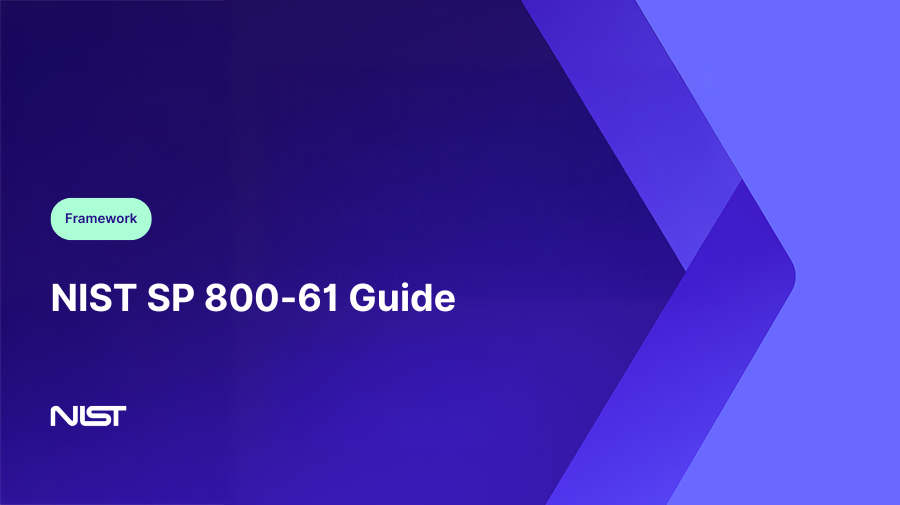
NIST SP 800-61 Guide
Comprehensively responding to security incidents is one of the most important components of a cybersecurity program. When a system is compromised or a data breach occurs, the speed and organization of your incident response will dictate whether the event rises to the level of a 'breach' or remains a minor incident.
This document introduces the concepts found in NIST SP 800-61, why they are important, and what you should consider while adopting these principles as part of your modern compliance program.
What is NIST SP 800-61?
NIST Special Publication 800-61, "Computer Security Incident Handling Guide," provides a structured approach to preparing for, detecting, analyzing, and responding to security incidents. NIST, the National Institute of Standards and Technology, developed the publication to help federal agencies and private sector organizations develop consistent, efficient processes for addressing incidents.
The framework emphasizes documentation, coordination, and continuous process improvement. It focuses on tmore than just containing incidents, but learning from these as well so as to strengthen defenses/resources in the future. Core objectives include:
- Improve detection and response times
- Help ensure coordination between the technical and management teams
- Standardize processes for reporting and gathering of evidence
- Decrease impact and restore normal operations in a timely manner
The incident response lifecycle
NIST SP 800-61 defines four primary phases that guide incident management:
Why incident response matters
Incident response planning has become a necessity. More sophisticated and frequent cyberattacks mean that even the most protected organizations will eventually experience an attack. Without a clearly written plan, teams will also lose time figuring out who is responsible for communication, roles, and decision making authority.
The results are late containment, extended downtimes, and increased regulatory risk. A robust incident response program will help organizations:
- Limit downtime and reduced impact to operations
- Collect critical evidence for follow-up investigation
- Provide regulatory notification (i.e., HIPAA, GDPR, DORA)
- Increase stakeholder and customer confidence in your organization.
Complyance helps organizations by providing automated workflows that will help capture incident specifics, assign tasks, and assign follow-up in real time.
Implementation Tips
Building a response capability aligned with NIST SP 800-61 requires structure, testing, and the right technology support.
Define roles and responsibilities: identify your incident response team, including executive sponsors, communication leads, and technical responders.
Create an incident classification matrix: define severity levels and escalation paths. Not every alert requires full escalation, but serious ones need predefined routes.
Automate evidence capture: integrate your response system with logs, SIEMs, and compliance tools to capture timestamps, actions, and artifacts automatically.
Run regular exercises: tabletop simulations and red-team exercises validate readiness and reveal procedural gaps.
Measure and improve: track response metrics such as detection time, mean time to containment (MTTC), and post-incident recovery performance.
NIST 800-61 vs ISO 27035
NIST SP 800-61 and ISO 27035 both present frameworks for the management of information security incidents, but their structure and emphasis are different.
The two can complement each other, with many organizations utilizing ISO 27035 as the governance overlay and using NIST 800-61 for technical implementation.
A well-defined incident response framework helps organizations move from chaos to control when security events occur.
NIST SP 800-61 provides the structure, while automation ensures consistency and speed.
Complyance supports enterprise teams by embedding incident response directly into their GRC platform (from automated evidence capture to audit-ready reporting) reducing manual work and ensuring every action is documented.
Explore how Complyance automates incident response and evidence capture across your GRC environment. Book a demo today!
FAQs
Who needs to comply with NIST 800-61? Any organization that handles sensitive data or provides services to the US government should follow the guidance. Even outside of federal environments, it’s considered a best practice framework.
How often should incident response plans be tested? At least annually, though quarterly simulations are ideal for high-risk industries such as finance or healthcare.
How does NIST 800-61 support compliance with other frameworks? It maps to requirements across FedRAMP, ISO 27001, and SOC 2 by reinforcing audit readiness, accountability, and traceability.




